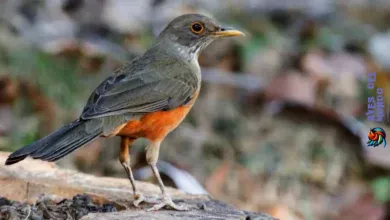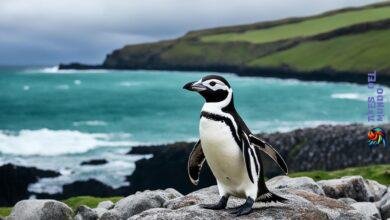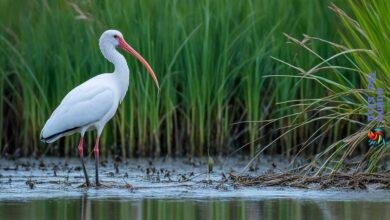Emperor penguins, also known as penguins emperor, are truly remarkable creatures. As the largest, deepest diving, and hardiest species of penguin in the world, they captivate the imagination of nature enthusiasts and scientists alike. The emperor penguin’s habitat, primarily in Antarctica, provides the perfect environment for these remarkable animals to thrive.
Standing at an impressive height of about 122 cm and weighing between 20 – 45 kg, emperor penguins showcase their magnificent stature. With a white underbelly that camouflages them against light from above and dark back feathers that blend effortlessly with the sea depths, emperor penguins are truly masters of disguise. Their classic «tuxedo» appearance further adds to their charm, making them instantly recognizable.
Key Takeaways:
- Emperor penguins are the largest and deepest diving species of penguin.
- They have a height of about 122 cm and weigh between 20 – 45 kg.
- Their white underbelly and dark backs provide perfect camouflage in their habitat.
- They are known for their classic «tuxedo» appearance.
- Emperor penguins primarily inhabit the frigid landscapes of Antarctica.
Emperor Penguin Behavior
Emperor penguins, known for their unique behaviors, exhibit fascinating characteristics in their Antarctic habitat. They are the only penguin species that breed during the harsh Antarctic winter, beginning their courtship in April when the sea ice reforms and becomes thick enough to support colonies. This exclusive breeding behavior sets them apart from other penguin species.
Male emperor penguins attract mates through an impressive display of strutting and distinctive breeding calls, creating a remarkable spectacle on the ice. After successful courtship, the female emperor penguins lay a single egg and entrust it to the males, who dutifully keep the eggs warm on their feet. This dedicated paternal care by the males during the cold winter months ensures the survival of their offspring.
«Emperor penguins devote themselves to the well-being of their eggs, demonstrating remarkable dedication and resilience.»
Emperor penguins are known to be serially monogamous, forming partnerships for a single breeding season. This commitment to their mates and offspring showcases their strong family bonds and cooperative nature. These extraordinary behaviors contribute to their survival in an unforgiving environment and make them a captivating subject of scientific study and admiration.
Emperor Penguin Behavior
| Behavior | Description |
|---|---|
| Breeding during winter | Emperor penguins breed during the Antarctic winter, beginning their courtship in April. |
| Prominent courtship display | Male penguins attract mates through impressive strutting and distinctive breeding calls. |
| Paternal care | Males keep the eggs warm on their feet, ensuring the survival of the offspring. |
| Serial monogamy | Emperor penguins form partnerships for a single breeding season, displaying strong family bonds. |

The remarkable behaviors of emperor penguins highlight their adaptability and resilience in the harsh Antarctic environment. Studying their behavior provides valuable insights into the strategies employed by these remarkable creatures to thrive in one of the most extreme conditions on Earth.
Emperor Penguin Diet and Diving
Emperor penguins, as impressive hunters, rely on a diet comprising Antarctic silverfish, krill, and select species of squid to sustain their energy and nutritional needs. Their diet is crucial in maintaining their physical condition and ability to breed successfully.
These skillful predators consume an average of two to three kilograms of food per day. However, as the breeding season or molting period approaches, emperor penguins increase their food intake to meet the demands of these critical life stages.
Emperor penguins showcase remarkable diving prowess, enabling them to explore the depths of the ocean in search of food. With the capacity to dive to depths of up to 500 meters, they embark on expeditions beneath the icy waters to secure nourishment for their survival.
When submerged, emperor penguins can stay underwater for up to 22 minutes at a time. Their extraordinary diving abilities are facilitated by their robust skeletal structure, characterized by solid bones that allow them to endure the pressures of deep dives and navigate the underwater environment with ease.
| Emperor Penguin Diet and Diving |
|---|
 |
Emperor Penguin Adaptations
Emperor penguins have developed remarkable adaptations to survive in the harsh Antarctic conditions. These adaptations enable them to thrive in an environment where temperatures can drop to -40°C and wind speeds can reach up to 200 km/h.
One of the key adaptations of emperor penguins is their incredible insulation. They have multiple layers of scale-like feathers that help retain body heat and provide protection against the icy winds. These feathers create a barrier that prevents heat loss, keeping the penguins warm even in subzero temperatures.
Their large fat reserves also play a vital role in heat preservation. These fat deposits act as insulation and help the penguins maintain their body temperature. Additionally, emperor penguins have small beaks and flippers, which minimize heat loss and reduce the surface area exposed to the cold air.
To further combat the extreme cold, emperor penguins gather in large huddles for warmth. These huddles consist of hundreds or even thousands of penguins, tightly packed together. This collective behavior allows the penguins to conserve energy and maintain body heat. Remarkably, the huddle can reach temperatures of up to 24°C, significantly higher than the surrounding environment.
«The emperor penguin’s adaptations enable it to thrive in one of the harshest environments on Earth, showcasing nature’s resilience and ingenuity.»
Emperor penguins exhibit remarkable physical adaptations and social behaviors that enable them to survive in the challenging Antarctic climate. These adaptations are essential for their survival, ensuring that they can endure the harsh conditions that are synonymous with their habitat.

Penguin Adaptations: A Closer Look
Let’s dive deeper into some of the specific adaptations that make emperor penguins so well-suited to their Antarctic habitat:
| Adaptation | Description |
|---|---|
| Insulating Feathers | The multiple layers of scale-like feathers provide exceptional insulation, trapping air and preventing heat loss. |
| Large Fat Reserves | Emperor penguins store significant amounts of fat, which acts as insulation and a source of energy during long periods without food. |
| Small Beaks and Flippers | The compact size of their beaks and flippers reduces the surface area exposed to the cold air, minimizing heat loss. |
| Huddling Behavior | Penguins huddle together in large groups, reducing their exposure to the elements and conserving heat. |
These adaptations, combined with their remarkable resilience and social behaviors, allow emperor penguins to thrive in one of the most extreme environments on the planet.
Emperor Penguin Breeding and Chicks
Emperor penguins have a unique breeding behavior that sets them apart from other penguin species. They choose to breed on the sea ice of Antarctica, where they do not build nests like many other birds. Instead, they rely on their remarkable adaptation to the harsh environment to ensure the survival of their chicks.
After the female emperor penguin lays a single egg, she leaves it to the male and heads out to sea to replenish her energy through feeding. Meanwhile, the male takes responsibility for the precious egg, cradling it on his feet and keeping it warm. The males form tight huddles, using their bodies to shield the eggs from the freezing temperatures and winds of Antarctica.
During this incubation period, which lasts for about 65 to 75 days, the male emperor penguins undergo incredible hardships. They endure hunger and extreme cold, consuming no food and relying solely on their energy reserves to sustain them. However, their dedication is rewarded when the eggs finally hatch, marking the arrival of the emperor penguin chicks into the world.
| Emperor Penguin Breeding and Chicks | |
|---|---|
| Incubation Period | About 65 to 75 days |
| Parental Care | Male takes care of the egg |
| Chick Feeding | Both parents provide food |
Emperor penguin chicks are born small and vulnerable, covered in soft, grayish down feathers. They heavily rely on their parents for warmth, protection, and sustenance. Both the male and female take turns caring for the chicks, with the male returning from the sea to regurgitate food for the hungry youngsters.
As the chicks grow, they form nurseries within the tightly packed colonies, allowing them to keep warm and protected from the harsh Antarctic conditions. These nurseries become an essential part of the penguins’ social structure, providing additional support and safety for the vulnerable chicks.
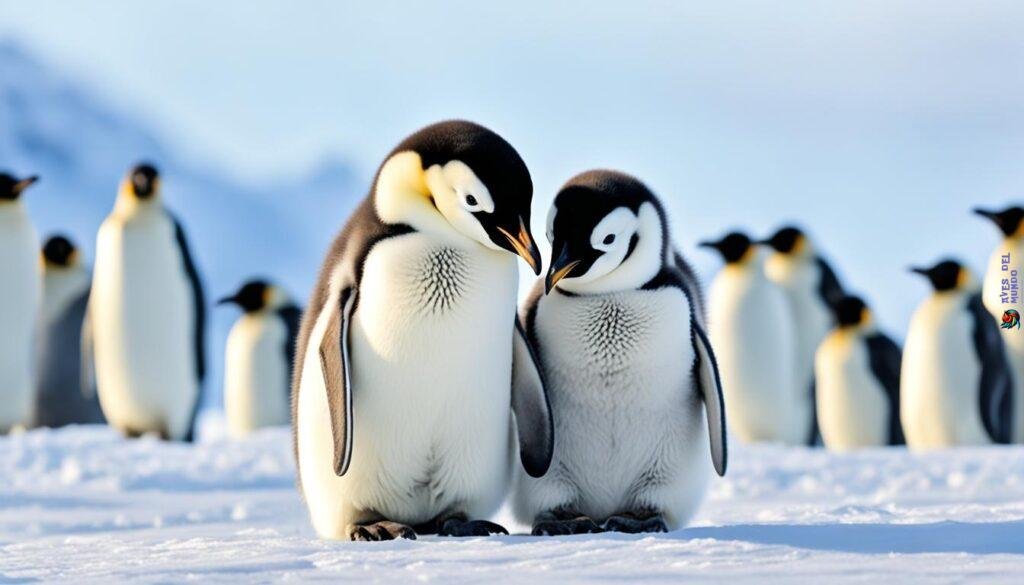
Emperor Penguin Populations and Conservation
Emperor penguin populations are facing significant challenges, and their conservation is of utmost importance. Currently, the species is classified as «near threatened» due to declining numbers in certain areas. The threats they face primarily stem from climate change and overfishing, which have severe implications for their survival.
The impact of rising temperatures, brought about by climate change, directly affects the sea ice that emperor penguins rely on for breeding and hunting. As the ice melts or becomes unstable, it disrupts their natural habitat and can lead to reduced breeding success and decreased access to food sources.
Overfishing, another critical concern, diminishes the availability of prey species such as Antarctic silverfish and krill. These small organisms make up a significant portion of the emperor penguin diet, and their depletion can have cascading effects throughout the entire food chain.
Conservation efforts aimed at protecting emperor penguins and their habitats are essential. By mitigating climate change through collective action and reducing carbon emissions, we can help preserve the stability of the Antarctic ecosystem. Additionally, sustainable fishing practices and the establishment of marine protected areas can ensure the availability of food sources for emperor penguins and other marine species.
«Conservation is crucial to safeguard emperor penguins and the delicate balance of their environment. By implementing effective measures, we can contribute to the long-term survival of this remarkable species.»
To better understand the current state of emperor penguin populations, let’s take a look at the following table:
| Emperor Penguin Population Statistics | Estimated Data |
|---|---|
| Total Number of Emperor Penguins | 595,000 |
| Breeding Colonies | 44 – 46 |
While the global population estimate may seem substantial, the conservation status of emperor penguins remains precarious due to the various challenges they face.
By prioritizing the conservation of emperor penguins and their habitats, we can ensure the continued existence of this remarkable species and contribute to the preservation of Antarctica’s extraordinary biodiversity.
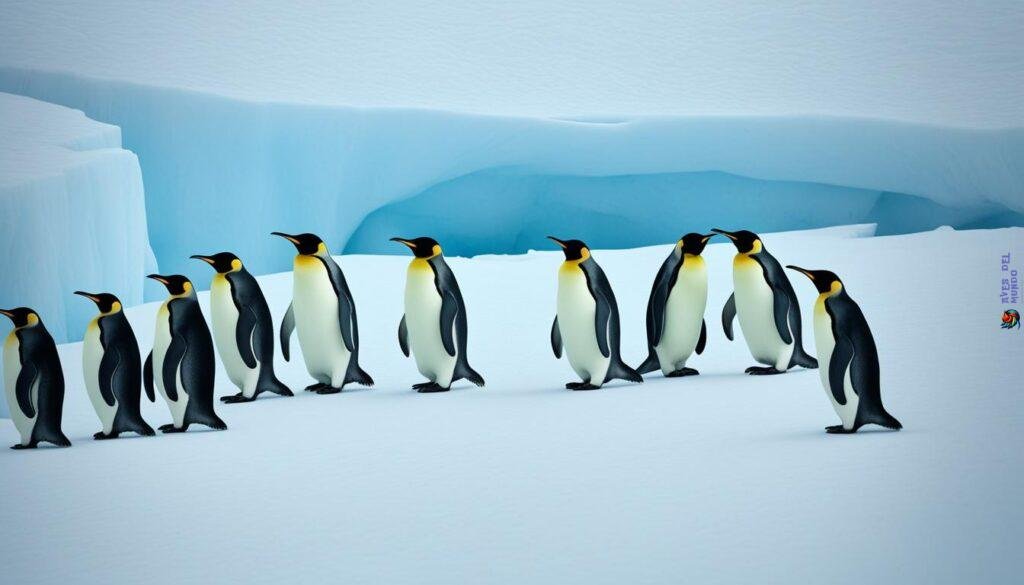
Emperor Penguin Sociability and Huddling
Emperor penguins, known for their remarkable behavior, display a unique sociability within their species. Unlike territorial creatures, emperor penguins thrive in large groups, relying on huddling to survive in the extreme Antarctic environment.
Emperor penguins huddle together in massive clusters, forming tightly packed circles. This behavior serves multiple purposes, primarily aimed at staying warm and reducing heat loss. By gathering closely, these resilient creatures create a shield against the frigid temperatures that can plummet as low as -40°C (-40°F).
The huddles of emperor penguins generate an astonishing phenomenon – a microclimate within their group. The temperature at the center of the huddle can reach as high as 24°C (75°F), a stark contrast to the icy surroundings. This enables these fascinating birds to endure the harsh Antarctic winters.
This cooperative behavior also creates a defense mechanism against katabatic winds, strong gusts that blow across the Antarctic landscape. By huddling together, emperor penguins reduce wind resistance, minimizing both heat loss and the risk of being blown away.
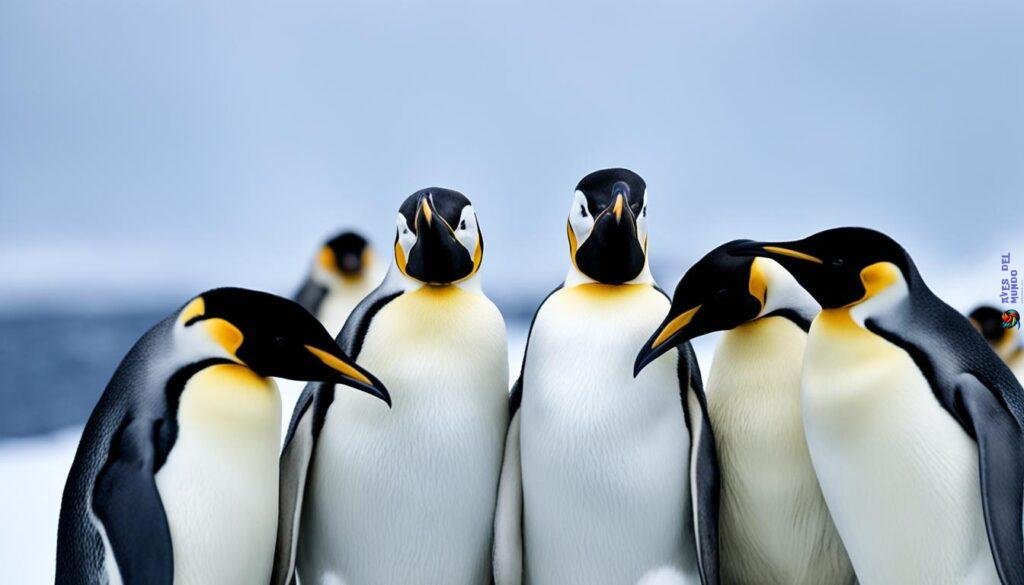
Huddling: An Essential Survival Strategy
Huddling is a vital part of the emperor penguin’s daily routine. Scientific studies have revealed that these penguins huddle for over 90% of their lives. By coming together in large numbers, they share body heat and conserve energy, allowing them to endure the harsh Antarctic conditions.
Complex dynamics govern the huddling process, with emperor penguins constantly shuffling between interior and exterior positions to maintain optimal body temperature. This coordinated movement ensures that every bird gets a chance to warm up in the center of the huddle before rotating towards the edges.
The huddling behavior of emperor penguins exemplifies their remarkable adaptability and social nature. It highlights their resilience in the face of extreme environmental challenges and portrays the strength they derive from interacting with their fellow colony members.
Emperor Penguin Distribution and Colonies
Emperor penguins, one of the two penguin species living on mainland Antarctica, have established between 44-46 breeding colonies across the icy continent. These colonies serve as vital habitats for their survival and reproductive success.
With their remarkable adaptability and resilience, emperor penguins have managed to thrive in the harsh conditions of Antarctica, utilizing different regions for colony formation. Each colony consists of hundreds to thousands of individuals, creating a bustling community within the icy landscape.
The global population of emperor penguins was estimated to be 595,000, surpassing previous estimations. However, despite their significant numbers, the species is still labeled as «near threatened» due to various conservation challenges that threaten their existence.
To gain a better understanding of the distribution and colonies of emperor penguins in Antarctica, refer to the table below:
Emperor Penguin Appearance and Lifespan
Emperor penguins are known for their striking black and white coloration, which helps them blend in with their icy Antarctic habitat. They have a white underbelly and dark back feathers, enabling them to camouflage against both the light from above and the dark depths of the sea. A unique feature of emperor penguins is the yellow markings on their head and neck, adding a touch of vibrant color to their appearance.
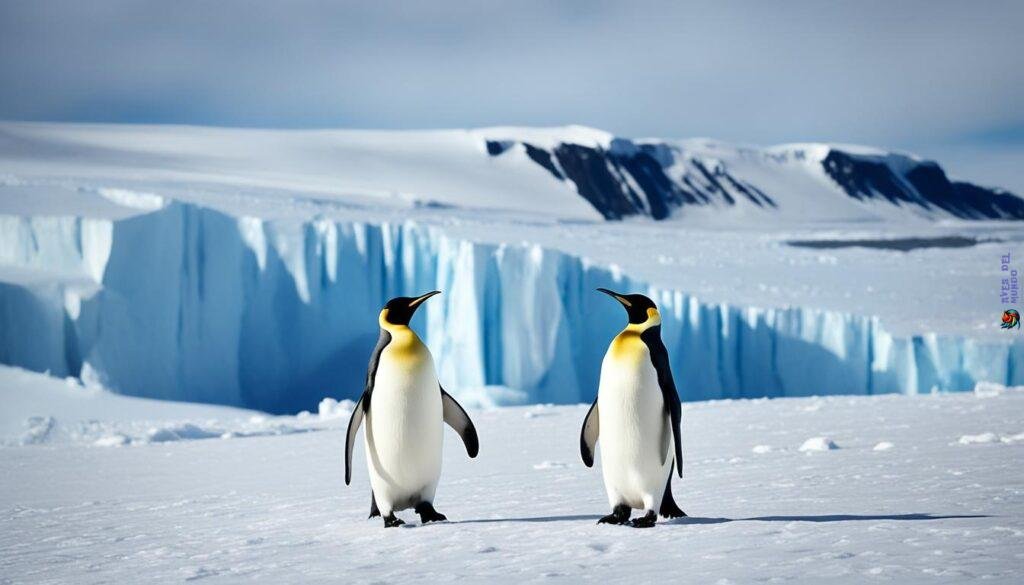
Standing at an impressive height of about 122 cm, emperor penguins are the tallest of all penguin species. They have a sturdy build, with adult males weighing between 20 – 45 kg. This substantial size allows them to endure the harsh conditions of their Antarctic home, from strong winds to icy temperatures.
«The distinctive appearance of an emperor penguin, with their formal tuxedo-like plumage, evokes a sense of elegance and regality.»
Emperor penguins have an average lifespan of approximately 20 years in the wild. However, some individuals have been known to live longer. Over the course of their lives, these remarkable creatures adapt to the extreme environment they inhabit, demonstrating astonishing resilience and remarkable survival skills.
Emperor Penguin Conservation Efforts
Conservation efforts are essential in ensuring the long-term survival of emperor penguins and the preservation of their habitats. Two major threats that pose a significant risk to these magnificent creatures are climate change and overfishing. Addressing these challenges is crucial to safeguard the future of emperor penguins.
The effects of climate change, such as rising temperatures and melting sea ice, directly impact the ability of emperor penguins to find suitable breeding and foraging grounds. As the sea ice diminishes, the penguins face difficulties in accessing their food sources and protecting their eggs and chicks from predators. Additionally, changes in ocean currents and reduced availability of krill, a vital food source, further exacerbate the challenges faced by emperor penguins.
Overfishing contributes to the decline of emperor penguin populations by depleting their main food sources, such as krill and fish. A diminished food supply not only compromises the penguins’ ability to breed successfully but also weakens their overall health and resilience to other environmental stressors.
To address these pressing conservation issues, concerted efforts are needed. Some of the key steps that can be taken include:
- Reducing carbon emissions to mitigate climate change and minimize the impact on ice-dependent species like emperor penguins.
- Establishing marine protected areas to preserve and safeguard the feeding and breeding grounds of emperor penguins and other marine life.
- Implementing sustainable fishing practices to ensure the long-term availability of krill and fish, which are crucial components of the emperor penguins’ diet.
- Supporting scientific research and monitoring programs to better understand the behavior, population dynamics, and ecological needs of emperor penguins.
- Working collaboratively with governments, conservation organizations, and local communities to raise awareness, promote responsible tourism, and foster environmental stewardship in penguin habitats.
| Conservation Actions | Impact |
|---|---|
| Reducing carbon emissions | Preserves sea ice habitats and reduces the effects of climate change on emperor penguins. |
| Establishing marine protected areas | Safeguards important foraging and breeding sites, ensuring the availability of food sources for emperor penguins. |
| Implementing sustainable fishing practices | Preserves the emperor penguins’ food sources and maintains the ecological balance of the Antarctic marine ecosystem. |
| Supporting scientific research and monitoring programs | Provides essential data to inform conservation strategies and identify potential threats to emperor penguins. |
| Collaborating with governments, organizations, and communities | Strengthens conservation efforts through shared knowledge, resources, and community engagement. |
«Conserving the emperor penguins requires a multi-faceted approach that addresses both climate change and overfishing. By working together and taking proactive conservation actions, we can protect these incredible creatures and their fragile Antarctic habitat.» – Dr. Jane Wilson, Marine Biologist
Through these conservation efforts, we can ensure a future where emperor penguins thrive in their natural environment, captivating future generations with their resilience and beauty. By prioritizing their conservation, we safeguard the rich biodiversity and delicate balance of the Antarctic ecosystem for the benefit of all species.
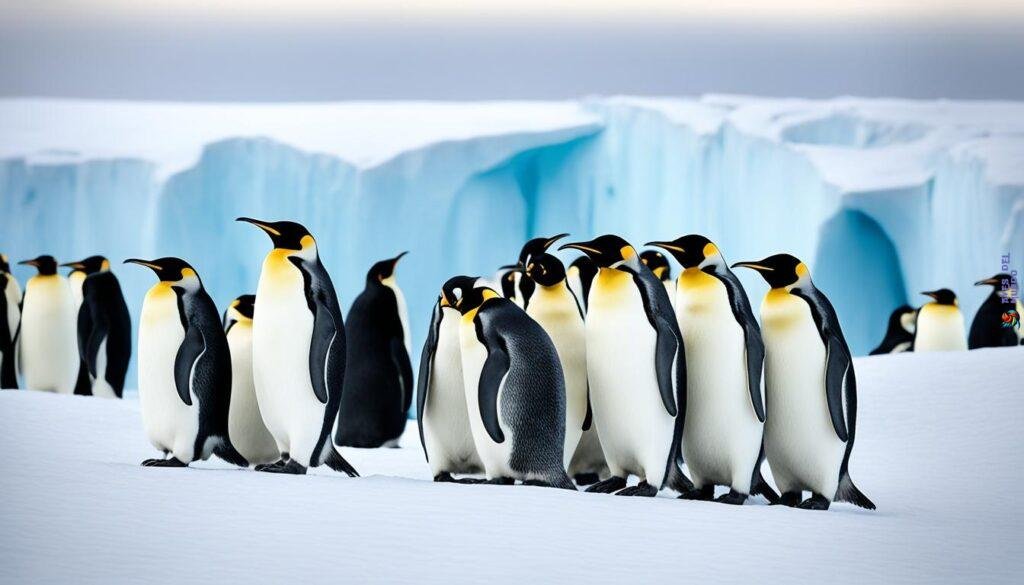
Observing Emperor Penguins in Antarctica
If you’ve ever dreamed of witnessing the wonders of the natural world up close, observing emperor penguins in Antarctica is an experience like no other. Nestled among the icy landscapes of the Weddell Sea and the Ross Sea, these cruises provide an incredible opportunity to observe emperor penguins in their pristine habitat.
While weather and ice conditions can occasionally affect accessibility, these trips offer an unforgettable chance to witness the unique behaviors and resilience of the emperor penguins. Imagine standing amidst vast colonies, observing their graceful movements, and witnessing the intricate dynamics of their social interactions.
As you watch emperor penguins in their natural environment, you’ll gain a deeper understanding of their behavior. From their impressive courtship rituals and breeding strategies to their incredible diving abilities and communal huddling, these majestic creatures have developed remarkable adaptations to survive in one of Earth’s most extreme environments.
Your journey to Antarctica to observe emperor penguins will not only leave you in awe of their beauty but also inspire a profound appreciation for the delicate balance of nature. The experience serves as a reminder of the importance of conservation efforts in safeguarding the habitats of these iconic creatures and preserving the future of the Antarctic ecosystem.
